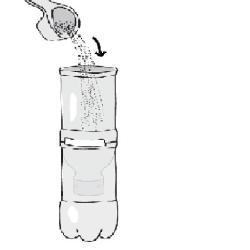Source Institutions
Source Institutions
Add to list Go to activity
Activity link broken? See if it's at the internet archive

Learners build a filter from old soda bottles and dirt. They create polluted water, and pour it through their filter to clean it. Leaners discover earth materials such as sand and dirt can be used to trap runoff pollution and that there are limits to what dirt can filter. These observations lead to valuable discussions about pollution. Extensions provided on pages 8 and 9 include building a better filter, a filter for acid rain, and formulating a way to measure filtration rates. Part of the 21-activity guide published by OMSI, No Hassle Messy Science with a Wow. All activities in this guide use household materials and all lesson plans include preparation directions, demonstrations, procedure sheets, cross-curricular connections, and scientific explanation of content.
- 30 to 45 minutes
- 30 to 45 minutes
- $1 - $5 per group of students
- Ages 11 - 18
- Activity, Experiment/Lab Activity, Lesson/Lesson Plan
- English
Quick Guide
Materials List (per group of students)
- plastic bottles 20 oz or 1-L 2 per group
- plastic caps from plastic bottles 1 per group
- drill with ⅛” bit for teacher
- scissors 1 per group
- masking tape 1 roll per group
- sand 2–3 cups per group
- cotton balls (optional) 1 per group
- pop-top squeeze bottles 16 oz.1 per group
- water 2 cups per group
- Variety of pollutants 1 tsp each per group, suggestions listed below
- vegetable oil
- very dilute tempera paint
- dirt
- sticks
- rocks
- paper
- Styrofoam
- 1–2 tablespoons per
- pollutant per group
- plastic cups 1 per pollutant for class to share
- plastic spoons 1 or 2 per pollutant
Subjects
-
Earth and Space Science
-
Earth Processes
- Weather and Climate
-
Earth Structure
- Rocks and Minerals
- Oceans and Water
-
Earth Processes
-
Engineering and Technology
-
Engineering
- Environmental Engineering
-
Engineering
-
Life Sciences
-
Ecology
- Ecosystems
- Human Impact
-
Ecology
-
Physical Sciences
-
Chemistry
- Solutions
- Structure and Properties of Matter
-
Chemistry
-
The Nature of Science
-
The Scientific Process
- Conducting Investigations
- Formulating Explanations
-
The Scientific Process
-
The Nature of Technology
-
Technology and Society
- Technology and the Environment
-
Technology and Society
Informal Categories
- Nature and Environment
Audience
To use this activity, learners need to:
- see
- read
- touch
Learning styles supported:
- Involves teamwork and communication skills
- Involves hands-on or lab activities
Other
Foreign language versions of this resource:
Components that are part of this resource:
Includes alignment to state and/or national standards:
Access Rights:
- Free access
By:
- Oregon Museum of Science and Industry
Rights:
- All rights reserved, Oregon Museum of Science and Industry, 2007
Funding Sources:
- National Science Foundation
- Camille and Henry Dreyfus Foundation
